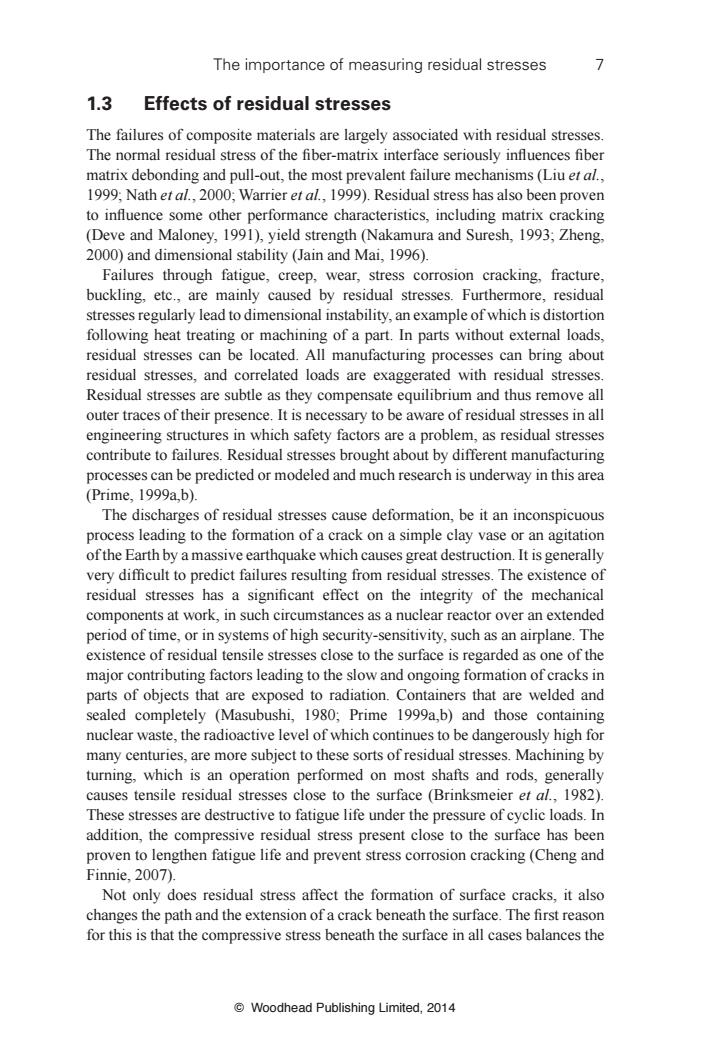正在加载图片...

The importance of measuring residual stresses 7 1.3 Effects of residual stresses The failures of composite materials are largely associated with residual stresses. The normal residual stress of the fiber-matrix interface seriously influences fiber matrix debonding and pull-out,the most prevalent failure mechanisms(Liu et al., 1999;Nath et al.,2000;Warrier et al.,1999).Residual stress has also been proven to influence some other performance characteristics,including matrix cracking (Deve and Maloney,1991),yield strength (Nakamura and Suresh,1993;Zheng, 2000)and dimensional stability (Jain and Mai,1996). Failures through fatigue,creep,wear,stress corrosion cracking,fracture, buckling,etc.,are mainly caused by residual stresses.Furthermore,residual stresses regularly lead to dimensional instability,an example of which is distortion following heat treating or machining of a part.In parts without external loads, residual stresses can be located.All manufacturing processes can bring about residual stresses,and correlated loads are exaggerated with residual stresses. Residual stresses are subtle as they compensate equilibrium and thus remove all outer traces of their presence.It is necessary to be aware of residual stresses in all engineering structures in which safety factors are a problem,as residual stresses contribute to failures.Residual stresses brought about by different manufacturing processes can be predicted or modeled and much research is underway in this area (Prime,1999a,b). The discharges of residual stresses cause deformation,be it an inconspicuous process leading to the formation of a crack on a simple clay vase or an agitation of the Earth by a massive earthquake which causes great destruction.It is generally very difficult to predict failures resulting from residual stresses.The existence of residual stresses has a significant effect on the integrity of the mechanical components at work,in such circumstances as a nuclear reactor over an extended period of time,or in systems of high security-sensitivity,such as an airplane.The existence of residual tensile stresses close to the surface is regarded as one of the major contributing factors leading to the slow and ongoing formation of cracks in parts of objects that are exposed to radiation.Containers that are welded and sealed completely (Masubushi,1980;Prime 1999a,b)and those containing nuclear waste,the radioactive level of which continues to be dangerously high for many centuries,are more subject to these sorts of residual stresses.Machining by turning,which is an operation performed on most shafts and rods,generally causes tensile residual stresses close to the surface (Brinksmeier et al.,1982). These stresses are destructive to fatigue life under the pressure of cyclic loads.In addition,the compressive residual stress present close to the surface has been proven to lengthen fatigue life and prevent stress corrosion cracking (Cheng and Finnie,2007). Not only does residual stress affect the formation of surface cracks,it also changes the path and the extension of a crack beneath the surface.The first reason for this is that the compressive stress beneath the surface in all cases balances the Woodhead Publishing Limited,2014The importance of measuring residual stresses 7 © Woodhead Publishing Limited, 2014 1.3 Effects of residual stresses The failures of composite materials are largely associated with residual stresses. The normal residual stress of the fi ber- matrix interface seriously infl uences fi ber matrix debonding and pull- out, the most prevalent failure mechanisms (Liu et al. , 1999; Nath et al. , 2000; Warrier et al. , 1999). Residual stress has also been proven to infl uence some other performance characteristics, including matrix cracking (Deve and Maloney, 1991), yield strength (Nakamura and Suresh, 1993; Zheng, 2000) and dimensional stability (Jain and Mai, 1996). Failures through fatigue, creep, wear, stress corrosion cracking, fracture, buckling, etc., are mainly caused by residual stresses. Furthermore, residual stresses regularly lead to dimensional instability, an example of which is distortion following heat treating or machining of a part. In parts without external loads, residual stresses can be located. All manufacturing processes can bring about residual stresses, and correlated loads are exaggerated with residual stresses. Residual stresses are subtle as they compensate equilibrium and thus remove all outer traces of their presence. It is necessary to be aware of residual stresses in all engineering structures in which safety factors are a problem, as residual stresses contribute to failures. Residual stresses brought about by different manufacturing processes can be predicted or modeled and much research is underway in this area (Prime, 1999a,b). The discharges of residual stresses cause deformation, be it an inconspicuous process leading to the formation of a crack on a simple clay vase or an agitation of the Earth by a massive earthquake which causes great destruction. It is generally very diffi cult to predict failures resulting from residual stresses. The existence of residual stresses has a signifi cant effect on the integrity of the mechanical components at work, in such circumstances as a nuclear reactor over an extended period of time, or in systems of high security- sensitivity, such as an airplane. The existence of residual tensile stresses close to the surface is regarded as one of the major contributing factors leading to the slow and ongoing formation of cracks in parts of objects that are exposed to radiation. Containers that are welded and sealed completely (Masubushi, 1980; Prime 1999a,b) and those containing nuclear waste, the radioactive level of which continues to be dangerously high for many centuries, are more subject to these sorts of residual stresses. Machining by turning, which is an operation performed on most shafts and rods, generally causes tensile residual stresses close to the surface (Brinksmeier et al. , 1982). These stresses are destructive to fatigue life under the pressure of cyclic loads. In addition, the compressive residual stress present close to the surface has been proven to lengthen fatigue life and prevent stress corrosion cracking (Cheng and Finnie, 2007). Not only does residual stress affect the formation of surface cracks, it also changes the path and the extension of a crack beneath the surface. The fi rst reason for this is that the compressive stress beneath the surface in all cases balances the